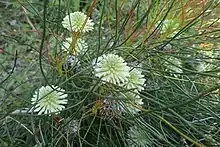| Petrophile filifolia | |
|---|---|
 | |
| In Kings Park, Perth | |
| Scientific classification | |
| Kingdom: | Plantae |
| Clade: | Tracheophytes |
| Clade: | Angiosperms |
| Clade: | Eudicots |
| Order: | Proteales |
| Family: | Proteaceae |
| Genus: | Petrophile |
| Species: | P. filifolia |
| Binomial name | |
| Petrophile filifolia | |
| Synonyms[1] | |
| |
Petrophile filifolia is a species of flowering plant in the family Proteaceae and is endemic to southwestern Western Australia. It is a small shrub with curved, long, needle-shaped leaves and more or less spherical heads of hairy cream-coloured to pale yellow flowers.
Description
Petrophile filifolia is a shrub that typically grows to a height of up to 0.5 m (1 ft 8 in). Its leaves are glabrous, curved, needle-shaped, 130–280 mm (5.1–11.0 in) long and 0.9–1.5 mm (0.035–0.059 in) wide. The flowers are arranged on the ends of branchlets in sessile, more or less spherical heads with a few narrow egg-shaped involucral bracts at the base. The flowers are about 17–25 mm (0.67–0.98 in) long, densely hairy and cream-coloured to pale yellow. Flowering mainly occurs from October to January and the fruit is a nut, fused with others in a oval head 15–28 mm (0.59–1.10 in) long and 14–20 mm (0.55–0.79 in) wide.[2][3]
Taxonomy
Petrophile filifolia was first formally described in 1810 by Robert Brown in the Transactions of the Linnean Society of London.[4][5] The specific epithet (filifolia) means "thread-leaved".[6]
In 2005, Barbara Lynette Rye and Michael C. Hislop described two subspecies in the journal Nuytsia and the names are accepted by the Australian Plant Census:
- Petrophile filifolia R.Br. subsp. filifolia;[7]
- Petrophile filifolia subsp. laxa Rye & Hislop[8] that differs from the autonym in having flowers with longer hairs on the pollen presenter.[2]
Distribution and habitat
This petrophile grows in a variety of habitats between Armadale, the Perup River, the Stirling Range and Albany in the Jarrah Forest biogeographical region of southwestern Western Australia.[3] Subspecies laxa grows in woodland and heath in the Armadale-Wandering area.[9]
Conservation status
Petrophile filifolia is classified as "not threatened"[3] but subsp. laxa is classified as "Priority Three" by the Government of Western Australia Department of Parks and Wildlife meaning that it is poorly known and known from only a few locations but is not under imminent threat.[9][10]
References
- 1 2 "Petrophile filifolia". Australian Plant Census. Retrieved 12 December 2020.
- 1 2 Rye, Barbara L.; Hislop, Michael C. (2005). "A taxonomic update of Petrophile sect. Arthrostigma (Proteaceae)" (PDF). Nuytsia: 467–470. Retrieved 12 December 2020.
- 1 2 3 "Petrophile filifolia". FloraBase. Western Australian Government Department of Biodiversity, Conservation and Attractions.
- ↑ "Petrophile filifolia". APNI. Retrieved 12 December 2020.
- ↑ Brown, Robert (1810). "On the Proteaceae of Jussieu". Transactions of the Linnean Society. 10: 69.
- ↑ Sharr, Francis Aubi; George, Alex (2019). Western Australian Plant Names and Their Meanings (3rd ed.). Kardinya, WA: Four Gables Press. pp. 198–199. ISBN 9780958034180.
- ↑ "Petrophile filifolia subsp. filifolia". Australian Plant Census. Retrieved 12 December 2020.
- ↑ "Petrophile filifolia subsp. laxa". Australian Plant Census. Retrieved 12 December 2020.
- 1 2 "Petrophile filifolia subsp. laxa". FloraBase. Western Australian Government Department of Biodiversity, Conservation and Attractions.
- ↑ "Conservation codes for Western Australian Flora and Fauna" (PDF). Government of Western Australia Department of Parks and Wildlife. Retrieved 12 December 2020.